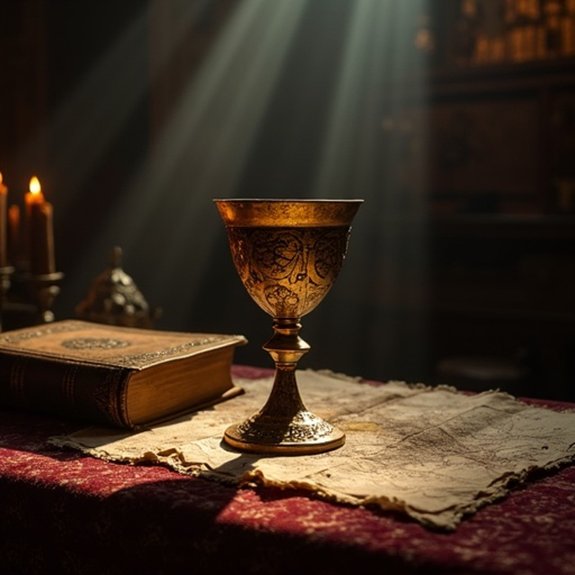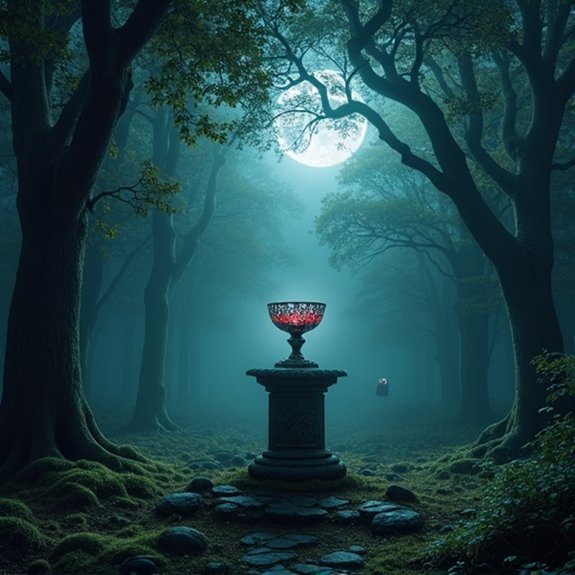The Legend of the Grail: Spiritual or Real?
The Holy Grail‘s emerged from ancient Celtic tales of magical cauldrons before Christianity transformed it into Christ’s cup. For over eight centuries, it’s sparked expeditions, inspired literature, and divided scholars who can’t agree whether it’s divine metaphor or lost artifact. Some claim they’ve found it in European churches or hidden caves. Others insist it exists only in humanity’s collective imagination. The truth remains tantalizingly out of reach.
Introduction

The Holy Grail—a chalice, dish, or stone of miraculous power—has captivated Western imagination for nearly a millennium. Medieval romances first popularized this mystical object, describing it as Christ’s cup from the Last Supper or the vessel that caught his blood at the crucifixion. Writers like Chrétien de Troyes and Wolfram von Eschenbach wove tales of knights undertaking perilous quests to find this sacred relic.
The Grail’s endured as both spiritual metaphor and archaeological obsession. Some view it as humanity’s search for divine connection or personal transformation. Others believe it’s a real artifact hidden somewhere in Europe or the Middle East. This duality raises fundamental questions: Does the Grail represent an inner journey toward enlightenment, or does a physical object await discovery?
Celtic Mythology’s Sacred Cauldrons
Celtic mythology brims with magical cauldrons that predate the Grail romances by centuries, offering tantalizing parallels to the Christian chalice. The Dagda’s Cauldron, one of Ireland’s four treasures, couldn’t leave anyone unsatisfied and represented endless abundance. Similarly, Cerridwen’s cauldron granted wisdom and poetic inspiration to those who tasted its brew.
Welsh tradition preserved the most striking precursor in Bran the Blessed’s cauldron of rebirth, which restored dead warriors to life. The Mabinogion describes Pryderi’s magical vessel that produced whatever food one desired. These Celtic cauldrons shared key attributes with the later Grail: they provided sustenance, healed wounds, and connected mortals to divine power. Medieval writers likely drew from these pagan sources, transforming the cauldron’s symbolism into Christianity’s sacred cup.
Notable Cases or Sightings

From ancient mythology to documented history, accounts of Grail discoveries have captivated believers and skeptics alike for nearly a millennium. Medieval chronicles record numerous claims of finding the sacred vessel. In 1135, Spanish monks at Valencia’s Cathedral declared they’d acquired the authentic chalice. The Genoa Cathedral‘s green glass dish, seized during the Crusades, sparked Italy’s competing assertion. Meanwhile, Nazi expeditions to Montségur Castle in 1944 sought the Grail among Cathar ruins, finding nothing.
Modern sightings haven’t ceased. In 2014, Spanish historians claimed they’d located the true cup in León’s Basilica. British researchers have proposed Nanteos Cup in Wales fits the description. Each discovery generates headlines, yet none withstand rigorous authentication. Carbon dating, metallurgical analysis, and historical verification consistently debunk these claims.
Common Theories or Explanations
While skeptics dismiss the Grail as pure fiction, scholars have developed several compelling theories about its origins and meaning. The most prevalent theory links it to Christian symbolism, representing Christ’s sacrifice and divine grace. Medieval literature scholars argue it’s purely a literary device created by Chrétien de Troyes to explore themes of spiritual quest and knightly virtue.
Some historians propose Celtic origins, connecting the Grail to magical cauldrons in Welsh mythology that could restore life. Others suggest it’s based on real Byzantine or Middle Eastern artifacts brought to Europe during the Crusades. Psychologist Carl Jung interpreted it as an archetype representing humanity’s search for wholeness and self-realization. These diverse theories reflect the Grail’s enduring power to inspire both academic debate and spiritual contemplation.
Frequently Asked Questions
Can Anyone Search for the Holy Grail Today?
Anyone can search for the Holy Grail today. They’ll find various theories about its location, from Glastonbury to Valencia. Some seek it as a physical artifact, while others pursue it as a spiritual metaphor for enlightenment.
What Happens if Someone Finds the Real Grail?
If someone finds the real Grail, they’d likely face intense scrutiny from religious authorities, scientists, and skeptics demanding authentication. The discovery would spark global debate about faith, history, and the artifact’s true powers or significance.
Are There Any Active Grail Quest Organizations or Groups?
Several organizations actively pursue grail research today. They include academic societies studying medieval literature, religious groups exploring spiritual meanings, and amateur archaeology clubs. Some treasure hunters also search, though most scholars don’t consider their efforts credible.
Which Museums Claim to Have the Authentic Grail?
Several museums claim they’ve got the authentic grail. Valencia’s Cathedral displays the Santo Cáliz, while Genoa’s San Lorenzo Cathedral houses the Sacro Catino. The Metropolitan Museum exhibits the Antioch Chalice, though experts dispute all claims.
How Much Would the Grail Be Worth if Found?
If found, the Holy Grail’s worth couldn’t be measured in money. Experts believe it’d be priceless—a religious artifact that’d transform Christianity, attract millions of pilgrims, and spark international disputes over ownership and authenticity claims.


